The 1,200-year-old Hindu temple, carved from a single rock, will astonish everyone and lead some to believe it may be the construction technology of extraterrestrials.
In the 21st century, humans have discovered many ancient architectures built with remarkable precision and finesse, such as the Pyramids (Egypt), the Sun Gate (Bolivia), or the Longmen Grottoes (China). The Kailasa Temple (India) is also among these wonders. To this day, no one can explain how this mysterious architecture was created.

Kailasa Temple.
The Kailasa Temple is located 29 km northwest of Aurangabad, Maharashtra, India. It is part of the famous Ellora Caves, which house 34 temples and monasteries. Kailasa is a notable example of Dravidian architecture (characterized by square-shaped towers with intricately carved details).
This temple is a remarkable example of Dravidian architecture from the 8th century, known for its nearly perfect proportions, especially considering that at that time, people only had simple hand tools for construction and used elephants to transport heavy materials.
Beyond being a place of worship for ancient deities, it astonishes people as it is carved from a single rock with intricate patterns. This leads the world to question how ancient people could create such a masterpiece. What technology did they use to build it that remains inexplicable even in the 21st century?
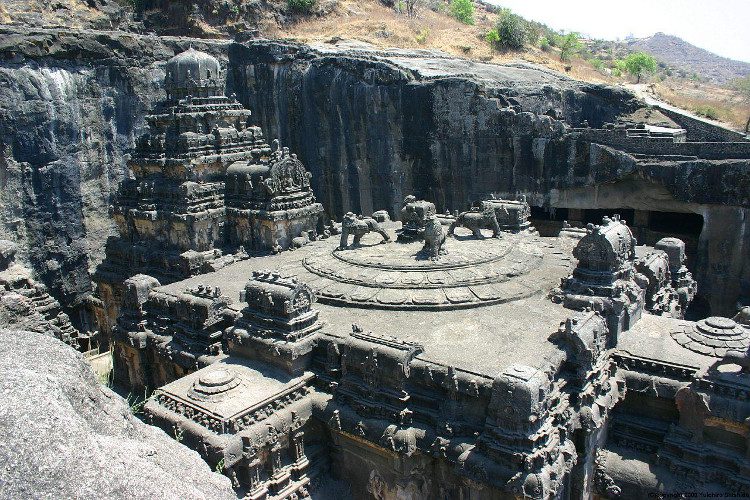
It is part of the famous Ellora Caves.
This sacred site was built by Krishna I, a king of the Rashtrakuta dynasty (which ruled over much of the Indian subcontinent from the mid-6th century to the 10th century). This site is dedicated to the Hindu god Shiva – the supreme deity symbolizing creation and destruction.
Indians often refer to it as the Kailash Temple. Kailash is a sacred mountain in Tibet, regarded as a holy site by many religions. According to Hindus, God Shiva resides on the summit of this mountain.
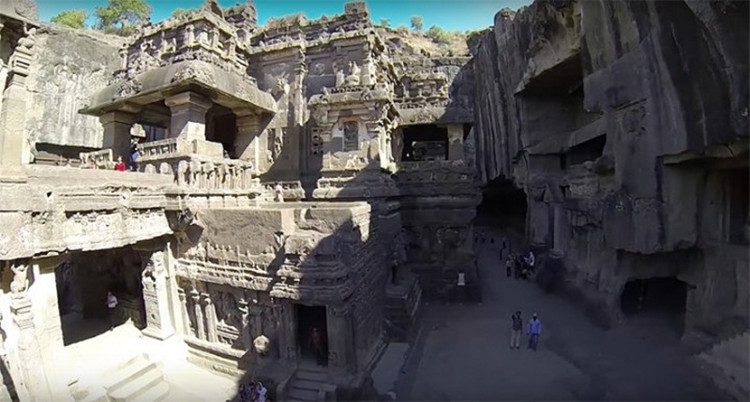
Indians often refer to it as the Kailash Temple.
This sacred site is estimated to have been constructed between 757 and 783 CE. Records indicate that the technique used for its construction is known as “carving from the rock.” However, it remains a mystery how ancient people managed to detach rock from a 30-meter-high cliff to create its pillars with only simple tools.
It is estimated that 400,000 tons of stone were used to create this worship site. Archaeologists and historians believe this monolithic structure was built over approximately 20 years. They hypothesize that workers labored continuously for 12 hours a day, regardless of rain or festivals. Thus, to construct this temple, they would need to extract 60 tons of rock daily, which equates to 5 tons per hour. With all the technology available today, we still cannot achieve this. Who did this and how? These questions remain unanswered.
A strange event occurred in 1682 when King Aurangzeb – a devout Muslim – ordered thousands to demolish this historical architecture. However, this seemed an impossible task as workers could only destroy a few statues over three years. Ultimately, King Aurangzeb had to abandon the effort. Hindus believe this reflects the power of the divine.
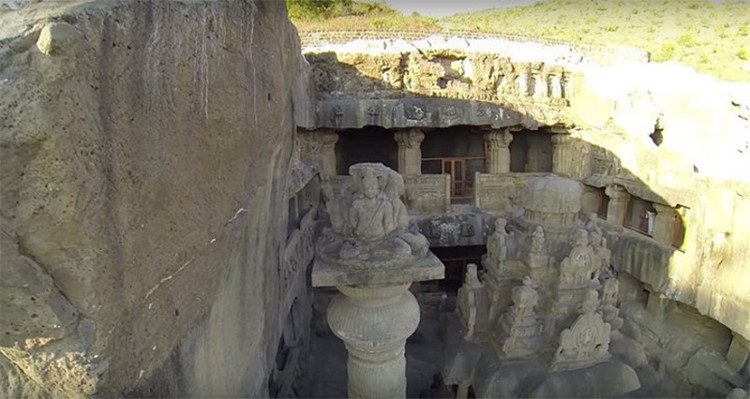
It is estimated that 400,000 tons of stone were used to create this worship site.
By examining the chisel marks on the stone walls, archaeologists concluded that three different types of tools were used to carve this century-old masterpiece, likely chisels, hammers, and sharp objects. They also believe the temple was carved from top to bottom, designed to be viewed from above as illustrated in the diagram.
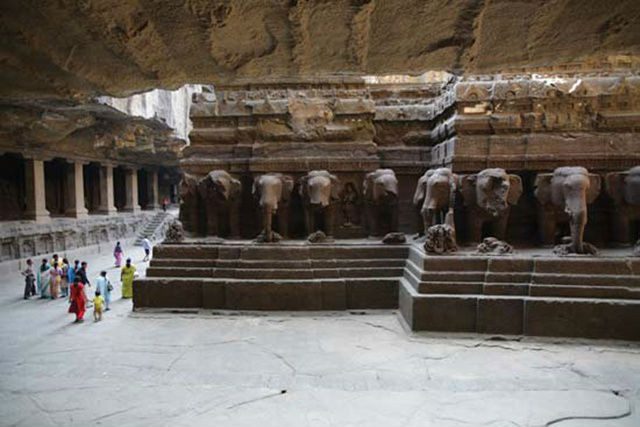
The temple was carved from top to bottom, designed to be viewed from above as illustrated.
From the outside, the 1,200-year-old Hindu temple carved from a single stone presents a U-shaped architecture. On either side of the main temple are 30-meter-high columns, upon which many deities are carved. In front of the sanctum is a statue of Nandi, the bull, which is the mount of Shiva, hence Nandi statues are always found before shrines dedicated to this deity. Inside the Kailasa complex, there are five separate shrines; three of these are dedicated to the river goddesses Ganga (Ganges), Yamuna, and Saraswati.
According to legend, when the king fell gravely ill, the queen prayed to Shiva to save her husband. She vowed to build a temple in Shiva’s honor and fast until she saw its roof. After the king recovered, the queen urged her husband to allow the immediate construction of the temple. However, all architects stated it would take many months to complete the roof. Only architect Kokasa dared to assert that he could finish the temple in a week. He chose a massive rock and instructed skilled workers to carve from the top down to shorten the construction time, so the queen would not have to fast for too long.

On either side of the main temple are 30-meter-high columns, upon which many deities are carved.
Within this sacred site, there are numerous elephant statues. Many humorously suggest that from above, Kailasa resembles a fortress guarded by a herd of elephants.

The deities carved to the left of the entrance are believed to be devotees of Shiva.
Experts believe that the temple is made from basalt stone. Its predominant architectural style is Dravidian. The Kailasa Temple features a square-shaped tower with intricately carved details, standing approximately three stories high. The temple includes a courtyard shaped like a horseshoe and a Gopuram tower at the entrance. On either side of the main temple are 30-meter-high columns, upon which many deities are carved. The dimensions of the temple courtyard are 82 x 46 meters.
In the courtyard, there is a central shrine dedicated to Shiva – the supreme god symbolizing creation and destruction. In front of the sanctum is a statue of Nandi, Shiva’s bull, carved from a stone hidden beneath the ground.
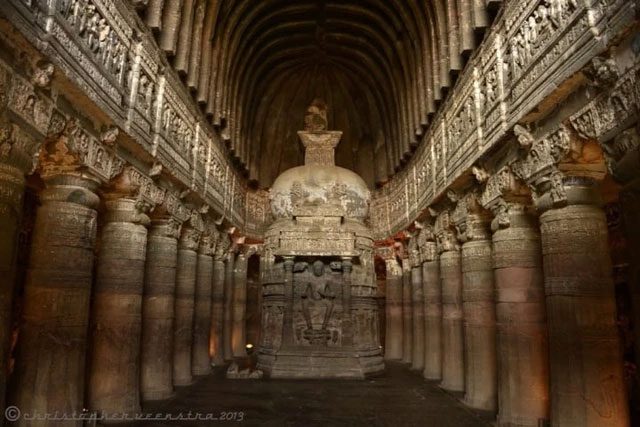
Image inside the temple. (Photo: Pinterest).
Inside this architecture are columns, windows, and various rooms. At the center of the sanctum is a massive stone linga.
The deities carved to the left of the entrance are believed to be devotees of Shiva, while those on the right are devotees of Vishnu – the protector deity, who is one of the three main deities in Hinduism alongside Shiva and Brahma.
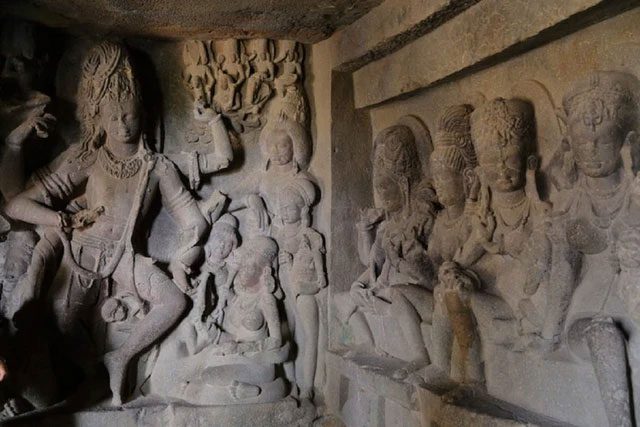
Statues of deities carved on the temple walls. (Photo: Pinterest).
Beside Shiva, there are two large pillars and sculptures depicting stories related to this deity. Additionally, there are sculptures of elephants at the base, making the temple appear as if it is being supported by a herd of elephants… All the details are exquisitely crafted.
In our modern age, where technology has advanced significantly, it is hard to imagine that over 10 centuries ago, humans could create such magnificent architecture from hard stone using only a few rudimentary tools. Even more astonishing is the fact that, despite having many advanced devices today, we still cannot replicate their achievements.
The Kailasa Temple not only holds architectural value but also serves as a showcase of the artistic and philosophical richness of ancient Indian civilization. Notably, one of the temple’s stone slabs features carvings that depict the grand epic of the Ramayana. To date, it is estimated that around 32 million Sanskrit inscriptions remain untranslated here.




















































